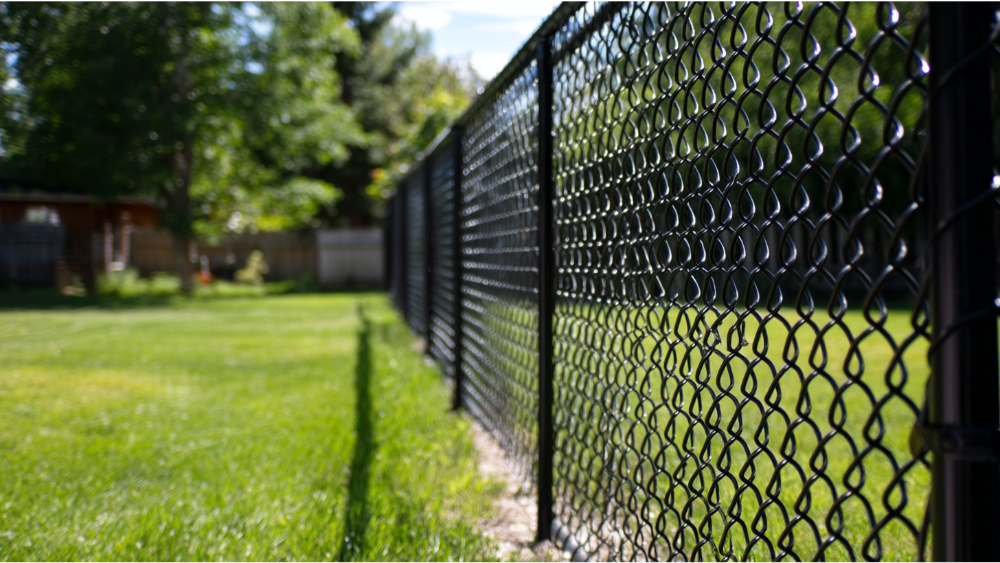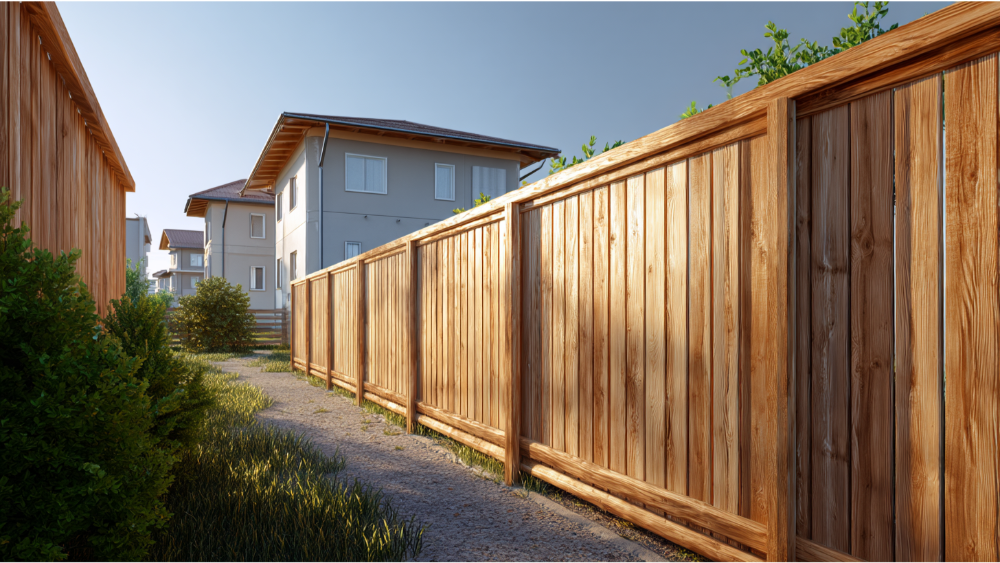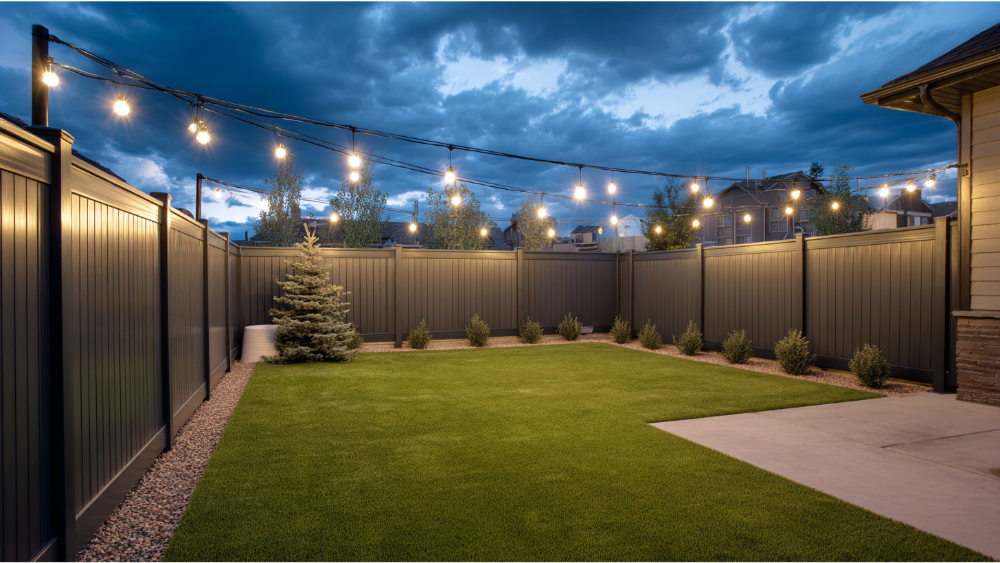Why Cost Matters: Setting Your Expectations for Your Fence Budget
If you’re putting up a fence, cost is probably at the top of your list. Fencing prices vary greatly depending on the material, height, labor costs, construction sites challenges, and region, but the good news is there are trustworthy, affordable fencing solutions that will secure your space without breaking the bank.
In 2025, national averages for fence installation range from $1 to $70 per linear foot installed. That means a 100‑foot fence could cost anywhere from $100 to $7,000+ depending on what you choose, like a simple chain link fence or a full plank wood fence, and how you build it.
Beyond material costs, most homeowners should factor in labor costs, permits, terrain obstacles, maintenance costs, and extras like this gate or decorative picket styles. While the cheapest fence options might save you money upfront, balancing long‑term durability, minimal maintenance, and aesthetic appeal ensures your investment stands the test of time.
What’s the Cheapest Fence to Put Up: Fencing Materials Compared by Cost, Use & Value

Before settling on a fence type, it helps to understand how different other fencing materials compare: chain link fencing, wood fencing, bamboo fences, trellis fencing, vinyl equipment, or even decorative picket fences. Whether your goal is privacy, property boundaries control, containment or curb appeal, the right material makes all the difference.
Budget Option #1: Barbed Wire Fencing (Heavy Gauge Wire)
Cost: $1–$4 per linear foot installed
Barbed wire uses heavy gauge wire, making it one of the cheapest fence ideas out there, commonly used for construction sites, agricultural zones, or rural livestock containment.
Pros:
- Extremely cheap in materials and labor.
- Covers long distances with minimal vertical posts.
- Gives a basic layer of security.
Cons:
- Zero privacy or decorative style.
- Not allowed in many residential zones.
- Fixed barbs make maintenance difficult, and there’s no aesthetic appeal.
Budget Option #2: Chicken Wire Fencing for Light Containment
Cost: $1–$6 per linear foot installed
Chicken wire is an inexpensive, lightweight fencing solution ideal for gardens, potted plants, small animals, or DIY trellis fencing. It also lets you support climbing vines or small outdoor plants without committing to a permanent solid fence.
Pros:
- Ideal for highly specific uses.
- Easy and fun DIY install.
- Works well with planting shrubs or vertical gardening.
Cons:
- Not strong enough for residential security.
- Wears out faster in weather exposure.
- Requires frequent upkeep and inspections.
Budget Option #3: Chain Link Fence – Secure & Functional

Cost: $9–$30 per linear foot installed
Chain link fencing is our workhorse choice for affordable fencing solutions. With metal posts, vertical posts, and heavy gauge wire, it provides durability and open view.
Pros:
- Long-lasting with minimal maintenance.
- Great for security, pets, or public property boundaries.
- Easy to enhance with slats or plants.
Cons:
- No privacy unless you hang privacy slats.
- Basic looks, not suited for decorative picket styles.
- Cold industrial aesthetic.
Budget Option #4: PVC Fencing & Vinyl Fence Panels
Cost: $20–$35 per linear foot installed
PVC fencing, or vinyl fence panels, give you that clean, modern look at a mid‑budget cost. They require minimal maintenance, resist rot and splintering, and let you mimic painted wooden fences.
Pros:
- Fantastic minimal maintenance and longevity.
- Clean lines and uniform appearance.
- Doesn’t need painting or staining.
Cons:
- Higher upfront investment.
- Can crack in extreme cold.
- Less eco‑friendly than natural options.
Budget Option #5: Bamboo Fences & Trellis Fencing
Cost: $6–$25 per linear foot installed
Bamboo fences offer a sustainable, exotic visual. Combine them with horizontal rails and climbing plants, or use as standalone panels for a tropical vibe.
Pros:
- Eco‑friendly and fast to install.
- Visually appealing with planting shrubs or vines.
- Suitable for tall fence needs.
Cons:
- Lifespan of 5–7 years max.
- Susceptible to plant diseases in humid climates.
- Require regular maintenance.
Budget Option #6: Wood Fence (Wooden Fence) – Classic & Versatile

Cost: $10–$45 per linear foot installed
Wooden fences are timeless. You have choices: picket fences, solid fences, or full plank fences. They come in types like pine (affordable) or cedar (premium). With wood or metal posts, you can build stable, customizable boundaries.
Pros:
- Priceless curb appeal and privacy.
- You can paint, stain, or decorate.
- Suitable for trellis fencing additions or vines.
Cons:
- Needs regular maintenance and staining.
- Prone to weathering and rot over time.
- Labor costs and materials can vary.
Budget Option #7: Aluminum Fencing – Budget Elegance
Cost: $25–$45 per linear foot installed
Aluminum fencing offers the ornamental look of wrought iron with minimal maintenance and corrosion resistance. It’s a graceful choice when you want decorative accents but still value efficiency.
Pros:
- Rust-proof and beautiful.
- Easy to customize in decorative picket styles.
- Great for property lines with minimal upkeep.
Cons:
- Doesn’t block vision, no privacy.
- Can dent more easily.
- Slightly pricier than chain link or wood.
Budget Option #8: Electric Fencing – Agricultural Use
Cost: $1–$10 per linear foot installed
Electric fencing is a low‑cost, functional option for farms or livestock. It uses posts, wires, and insulators, and manages animals without needing tall fence panels.
Pros:
- Inexpensive materials per square foot.
- Highly effective for animal control.
- Quick to dismantle or modify.
Cons:
- Limited to farm/residential exclusions.
- Needs power and consistent upkeep.
- Not visually appealing.
Should You DIY or Hire a Fencing Contractor? Real Cost Comparison

Going the DIY route on a fence project can seem like a smart way to save money, and in some cases, it is. Most homeowners can reduce their costs by 30% to 60% when installing a basic wood fence themselves, especially if they’re using cheap materials like reclaimed wood or prefabricated panels. But savings often come with trade-offs.
For example, misaligned vertical posts, incorrect spacing between fence panels, or skipped permit requirements can lead to costly mistakes. What started as a weekend project can quickly turn into a drawn-out, stressful experience, especially if you hit a buried utility line or build over a neighbor’s property line.
In 2025, one Seattle homeowner built a 225-foot cedar wood fence for around $2,700 using DIY methods, about $12 per linear foot installed. That same project quoted professionally ranged from $7,500 to $11,000, factoring in labor costs, complex terrain, and strict local permitting. The price difference is significant, but so is the peace of mind that comes with hiring an expert.
When you work with Inline Security Fence, you’re not just paying for installation, you’re investing in code-compliant work, high-quality materials like chain link fences or wood fencing, and a team that manages every detail from permitting to post-placement. We also back our work with a warranty, so you’re protected long after the last post is set. Whether you’re working with wood or metal posts, we’re here to get the job done right, the first time.
Maintenance, Regulations & Fire Safety: What to Watch
Choosing a fence isn’t just about cost and looks, it’s also about compliance and safety. In 2025 the international guidelines including the International Plant Protection Convention will require disease resistant and fire safe materials in residential construction. That affects fencing especially in fire prone areas of Washington state and the Pacific Northwest.
In these areas traditional wood fences or bamboo fences especially those near homes or structures may not meet code. Instead local regulations often recommend or require fire resistant fencing materials like corrugated metal, aluminum or treated wood fencing with metal posts. These materials not only slow down the spread of fire but also resist pests and plant diseases that affect untreated wood.
For most homeowners especially those building tall fence panels along property lines or near vegetation compliance with these new codes is crucial. Not following these rules can result in fines or having to replace non compliant fencing, more expensive in the long run.
That’s where Inline Security Fence comes in. Our team is up to date on all building codes and fire regulations to make sure your fence meets local and international standards. From material recommendations to installation techniques we’ll guide you to a fence that’s not only affordable but built to protect your home and your peace of mind.
Frequently Asked Budget Fencing Options Questions
What’s the absolute cheapest fence I can put up?
Barbed wire and heavy gauge wire like chicken wire start as low as $1 per linear foot installed, making them the most budget‑friendly fences you can get.
What’s the most affordable privacy fence?
Wood fences (full plank), solid cedar or vinyl fence panels, and even corrugated metal all offer privacy without over‑paying upfront.
Can I build a tall fence without a permit?
Most areas require a permit for a tall fence over 6 feet. Always verify with your local building department.
How much can I save by doing wood fence DIY?
DIY wood fences can reduce labor costs significantly, by 30 to 60 percent, but you’ll need the right tools, skills, and permits to get it right.
How long will a cheap fence type last?
Chain link and aluminum fences with metal posts can last 20+ years with minimal maintenance. Wooden fences and bamboo fences last 10–15 years if regularly treated. Electric fencing has variable lifespan based on hardware upkeep.
Does Inline Security Fence install chain link, wooden fence, vinyl, or aluminum fencing?
Absolutely, we specialize in all major fence types, including chain link fence, wooden fence, PVC fencing, aluminum fencing, bamboo fences, trellis fencing, & split rail/tree-lined fences.
Are rail fences a good budget option for large properties?
Yes, rail fences, especially split rail styles with horizontal rails, are a smart, cost‑effective way to mark property boundaries over large acreage.
What is hog wire fencing and is it worth the cost?
Hog wire fencing uses sturdy welded panels framed with wood, stronger than chicken wire and great for pet enclosures or decorative small animal pens.
How long does a split rail fence last?
A well‑built split rail fence using pressure‑treated or rot‑resistant wood can last 15–20 years with regular maintenance.
Is corrugated metal a good budget option for fencing?
Yes, corrugated metal is a great option if you want something durable without spending a fortune. While it’s not the cheapest upfront, it uses relatively cheap materials and lasts much longer than basic wood or wire. It’s perfect for a fence project that needs privacy and strength. When installed with wood or metal posts, corrugated metal fences offer a clean, modern look with minimal upkeep, making them one of the most practical metal fences for long-term value.
Can I grow climbing plants or vines on fence panels?
Absolutely, a trellis fencing setup with climbing vines or potted plants is an inexpensive material combo that enhances privacy and aesthetic appeal. Choose disease‑resistant plants to avoid plant diseases.
Final Thoughts: Smart Choices for Affordable Fencing Solutions
- Want a cheap yet secure solution? Choose a well‑built chain link fence.
- Trying decorative appeal? Consider a wooden fence with stylish picket fences panels or full plank design.
- Need a low‑maintenance long haul? Go with aluminum or vinyl fencing.
- Prefer a natural, low‑cost DIY option? Trellis fencing with climbing vines, bamboo fences, or reclaimed wood fences might do the trick.
We offer all these fence types, from wood fencing and chain link fences to bamboo fences and decorative picket styles. We’ll assess your outdoor space, recommend the cheapest fence options for your needs, and install using high-quality materials, wood or metal posts, vertical posts or rails, so they last.
Ready to Get Started? Let’s Build the Right Fence for Your Property
Choosing the right fence isn’t just about finding the cheapest option, it’s about getting the best value for your specific needs. Whether you’re protecting pets, adding privacy, defining property boundaries, or just boosting the curb appeal of your outdoor space, Inline Security Fence is here to help you do it right.
We offer expert guidance on everything from cheap materials and budget-friendly fence types to premium designs that elevate your property. Our team works with homeowners across the region to design and install durable, compliant, and great-looking fences using trusted materials, whether you prefer a classic wood fence, long-lasting chain link fencing, or modern metal fences like aluminum or corrugated steel.
No guesswork. No hidden fees. Just honest recommendations, top-tier workmanship, and a fence that fits your lifestyle and your budget.
Contact Inline Security Fence today for a free estimate, and let’s start building a fence you’ll feel good about for years to come.




